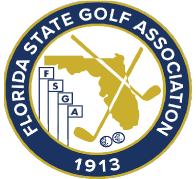TAMPA, Fla. – The FSGA’s first president, Clarence Camp, eight-time FSGA Player of the Year, Mary Jane Hiestand and U.S. Open and Florida Amateur champion, Jerry Pate have been selected as the 2023 FSGA Hall of Fame inductees. These three extraordinary individuals have done so much for the game of golf in Florida and around the country and will join an exceptional group of individuals in the FSGA Hall of Fame.
The 2023 class will be inducted into the FSGA Hall of Fame at the FSGA’s Annual Meeting and Dinner in Orlando in November. The Annual Dinner celebrates the best players in the state, tournament volunteers, board members and many other important individuals involved in the game of golf in Florida.
 Clarence Camp
Clarence Camp
An Ocala native, Clarence Camp was the first president of the Florida State Golf Association when the association was founded in 1913. Camp was an avid golfer and although he passed away in 1946, the legacy he left on the game of golf is still felt to this day.
“We’re so proud of the legacy that Clarence left in golf,” the Camp family said. “He loved golf, he promoted it, and this is such a great honor to him.”
Born in Virginia to William Nelson and Texana Camp, Clarence was the eldest of nine children. In 1891, the family moved to Florida just outside of Gainesville where William Nelson achieved great success mining phosphate, building hydro-electric power plants and raising cattle. The Camp family, including Clarence, settled in Ocala in the early 1900s, where members of the family still live today.
Clarence Camp, a golf enthusiast, purchased a nine-hole golf course in 1910 to save it from residential development. Originally opened as Ocala Heights Golf Club, the course was Ocala’s first golf course and thought to be one of the first in the state.
After purchasing the course, Camp renamed it to Ocala Country Club and replaced the original log structure with a new clubhouse that quickly became the social hub in Ocala, where family, friends and local golfers gathered. While the golf course was closed in the 1940s, the clubhouse Camp built remains to this day as a private residence.
Three years after purchasing Ocala Country Club, Camp met with representatives of other courses in Florida at the San Juan Hotel in Orlando and on February 27, 1913, the Florida State Golf Association was formed. In recognition of his standing among Florida's golf community, Camp was named the first president of the FSGA.
Camp served as the FSGA president for 27 years and is credited with helping bring the game to the Southern region of the country. He also served on the Board of Directors for the Southern Golf Association for more than 20 years.
In honor of what Camp did for the FSGA, each year the Florida Amateur winner is awarded the Clarence Camp Championship Trophy.
Mary Jane Hiestand
A lifelong amateur, Mary Jane Hiestand has been involved with the FSGA for more than 20 years, but has been a mainstay in the amateur golf scene for more than 30 years. She has captured nine FSGA championships and has been named a FSGA Player of the Year eight times on her way to this honor.
“It is obviously quite an honor, there are so many great players in this state that easily deserve Hall of Fame nominations. I am just honored to be one of the three this year to get that nod,” Hiestand said.

“I just have fun and really fond golf memories from that time, and I still keep in touch with some of the kids to this day,” Hiestand said.
When it came time for college, Hiestand headed to the University of Michigan and played on the women’s golf team for a season, before transferring to the University of Florida and graduated with a Bachelor of Science degree in Advertising in 1982.
After graduating from college, Hiestand made her way back to Michigan and took a step back from golf as she began her professional career as a real estate appraiser. She still played the game, but didn’t get back into the competitive golf space until her late twenties. This was when she won her first Michigan Women's Amateur Championship in 1990.
She would go on to add two more Michigan Women’s Amateur titles in 1995 and 2000, along with a Michigan Public Links title in 1999. The Naples resident was voted the Michigan Women Player of the Decade in 2000 and was inducted into the Michigan Golf Hall of Fame in 2004.
“Getting to the highest point in Michigan and then moving down here getting to the highest point in another state, is overwhelming to me. I just feel like I am a regular Joe and I am, but it is overwhelming to me that I am in two golf hall of fames,” Hiestand said.
Hiestand moved down to the Sunshine State in 2003. She and her family had been coming to Naples for holidays and spent time in Florida during the summers. When she reconnected with her now husband, Jeff, he was living in Florida. The two got married in 2002 and she made her way to Florida the following year.
Since moving to Florida, Hiestand has put together a stellar resume. She has been named the FSGA Women’s Senior Player of the Year seven times, the FSGA Women’s Player of the Year once and is a nine-time FSGA champion, including the Women’s Amateur Championship in 2007.
“I have met so many great friends and have had a wonderful 20 years with the FSGA. I did not really expect a Hall of Fame nod in 20 years. I am humbled and honored that you chose me,” Hiestand said.
In addition to her accomplishments at the state level, Hiestand has also had great success at the national level. She captured the Women’s Southern Mid-Amateur title in 2017 and has competed in 51 USGA championships. In 2017 at age 58, she played in her 43rd USGA championship and finished as the runner-up to Kelsey Chugg in the U.S. Women’s Mid-Amateur in Houston.

Hiestand is close and mentor’s players in Naples along with having spent time as a golf coach at the high school and college level. While in Michigan, she was the assistant coach at Oakland University and after moving to Florida was the girls’ golf coach at St. John Neumann Catholic High School. She also spent a few seasons at Florida Gulf Coast University, as the men’s golf assistant coach.
“I just want to be able to be that person,” Hiestand said. “I just want to help out the younger generation in any way that I can. I want to be involved with them in any little way I can.”
Jerry Pate
A U.S. Open champion and eight-time PGA Tour winner, Jerry Pate has made his mark on the golf world both on and off the course. Growing up in Pensacola, Pate won the 1974 Florida Amateur Championship and had a storied amateur and professional career, before delving into ventures in golf broadcasting and golf course design.
“The Hall of Fame is something I’ve always looked up to,” Pate said. “I’m just thankful for what I’ve been able to do and have a great family that supports me.”
Born in Macon, Georgia, Pate came from a family with a deep love of golf. Pate was one of six children and credits his passion and love to his father and grandfather. While spending summers down in Jacksonville Beach, a young Pate would get dropped off to play a small par-3 course on Beach Boulevard, while his father and grandfather played at The Ponte Vedra Club (now Ponte Vedra Inn & Club).
Moving to Alabama when he was very young, Pate learned to play the game at Anniston Country Club from his father, grandfather and the golf professionals at the course. His family moved to Florida in 1967 when his father was relocated for work.
When it came time for college, Pate headed to the University of Alabama where he walked onto the men’s golf team. Pate had not been a standout junior golfer but he always had the drive to become a better player.
“I didn’t like to lose for starters,” Pate said. “I was a pretty tenacious competitor. I was one of six children and we were always pushed by our parents to try and do better.”
 The turning point in his career came after his junior season in the summer of 1974. Never having played in an FGSA championship as a junior, Andy Bean convinced Pate to go down to Lakeland to play in the Florida Amateur Championship at Grenelefe Country Club.
The turning point in his career came after his junior season in the summer of 1974. Never having played in an FGSA championship as a junior, Andy Bean convinced Pate to go down to Lakeland to play in the Florida Amateur Championship at Grenelefe Country Club.
“I told him I wasn’t good enough to play in an amateur event like that,” Pate recalls with a laugh.
But despite that, Pate made his way to Lakeland and teed it up in the 59th Florida Amateur Championship. Pate raised the trophy at the end of the week, playing with Bean in the final round and beating him by one shot.
A few weeks later, Pate qualified for the 1974 U.S. Amateur Championship at San Jose Country Club in Jacksonville, the club where his grandfather had been a founding member. Pate won the U.S. Amateur at The Ridgewood Country Club, completing one of the most impressive match-play runs in history in his championship debut at 20 years old.
His storybook summer came to an end at the World Amateur Team Championship, where he helped lead the United States team to victory. The Pensacola resident was also a member of the victorious United States team at the 1975 Walker Cup and the low amateur at the 1975 U.S. Open Championship, finishing in a six-way tie for eighteenth place at Medinah Country Club.
Pate never had any intentions to turn professional after college, but after a great finish at the U.S. Open and some encouragement from his father, Pate decided to give it a go. He turned professional in 1975 and earned his PGA Tour card in the fall with medalist honors at PGA Tour Qualifying School.
His first professional win was a major one. In Pate’s first season on the PGA Tour, he won the 1976 U.S. Open at Atlanta Athletic Club at age 22. He earned it by coming from two strokes off the lead entering the final round to John Mahaffey, carding a final-round 68 to surge to the title.
“I told my dad before I went to Atlanta as a rookie that if I could get off to a good start, I can play hard golf courses and have a chance,” Pate said. “It took me 70 holes to catch Mahaffey, but I caught him.”
After a few missed cuts following his U.S. Open win, Pate went out and won the Canadian Open with a final-round 63 to beat Jack Nicklaus by four shots.
“That was a really rewarding moment because I could go home at night and know that I really could play. It showed my U.S. Open win wasn’t a fluke and it validated my place on the PGA Tour,” Pate said.
Pate went on to be selected the Rookie of the Year and the Co-Player of the Year after a storied first season on the PGA Tour. Six more PGA Tour victories followed for Pate, along with a victorious Ryder Cup win in 1981 but a shoulder injury at the age of 28 curtailed his career.
His final win on Tour came in the place where he learned to play the game – the 1982 Players Championship, the first held at TPC Sawgrass in Ponte Vedra Beach. Starting the final round three shots back of the leaders, Pate shot a final-round 67 to win by two strokes. After his victory, Pate pushed PGA Tour commissioner Deane Beman and course designer Pete Dye into the lake along the 18th green, and then joined them.
Pate had met Pete Dye, the legendary golf course architect and FSGA Hall of Famer, when he was competing at the World Amateur Team Championship in college. Pate, who has always had an interest in architecture, grew close with Dye and often picked his brain about course design.
Prior to the 1982 Players Championship, Beman invited all the players and others in the game to play the newly completed TPC Sawgrass. Pate was the only the player to make his way down to play, so he teed it up that day with Beman, who shared insight about how to best play the course.
“Beman said, ‘If you’ll just listen to me, I’ll show you how to win the Players next year,’” Pate said.
Sure enough, Pate was victorious next year.
 After his injury took him away from playing, Pate found a different way forward in different aspects of golf. The Alabama native served as a golf broadcaster for nearly 10 years, has opened a golf course design business, a turf and irrigation company, among many other things.
After his injury took him away from playing, Pate found a different way forward in different aspects of golf. The Alabama native served as a golf broadcaster for nearly 10 years, has opened a golf course design business, a turf and irrigation company, among many other things.
“If it hadn’t been for my injury, my life would have been very different,” Pate said. “I probably would have stayed on tour, but instead I got to spend time with my wife and my kids. I got to explore so many other things and have been able to do so many rewarding things. I can make a difference everyday by leading people in my company and my business.”
Pate has designed and developed more than 25 golf courses, including Kiva Dunes in 1995 and the Ol' Colony Golf Complex in 2000, which is the home course for his alma mater, the Alabama Crimson Tide golf team.
After being plagued by his shoulder injury for years, Pate finally found a surgery that worked in 2002 and made his way back to competing on the Champions Tour when he became eligible and captured two victories in 2006 and 2008.
Now Pate spends most of his time tending to his businesses and spending time with his wife of 48 years and their children and grandchildren.
“I’ve been fortunate to hit a lot of good golf shots, but I’ve been more fortunate to do good things for others.”





